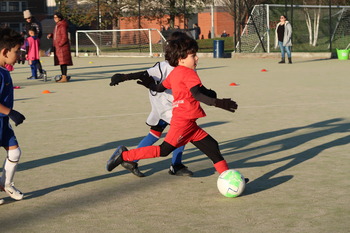It can be tough to keep up with modern football. Such is the speed of its evolution and rotation.
Defenders go from stoppers and sweepers to ball-playing outlets and surging threats, central midfield has become a diverse, multifaceted job and wingers don't bother to cross anymore.
UEFA Champions League and international football set the standards for the sport, and when high-profile coaches take on new philosophies and ideas, the rest copy in order to stay relevant.
These shifts in philosophy happen, on average, every three or four years. Players have two choices: change their game to stay at the top or refuse and become a dinosaur. It's the case with managers, too, but a player's drop-off is far more noticeable.
No position has been affected more heavily than the striker over the last decade or so, and to understand why, we need to check in on major influences on the game and how they changed the role.
What happened to the Rauls and Dwight Yorke/Andy Coles of this world? How did such a sure thing in front of goal just disappear? 
Strike Partnerships Die
In the 1998-99 season, Manchester United won the famous treble—Champions League, Premier League and FA Cup—in a campaign that remains the club's most successful to date.
Sir Alex Ferguson utilised a 4-4-2 formation throughout the year, relying on the goalscoring brilliance of Yorke and Cole to power through the opposition.
Striking partnerships were common, but none as prolific as this pair: Yorke secured 29 goals and Cole 24, while Ole Gunnar Solskjaer sat ready and waiting on the bench alongside Teddy Sheringham.
The 4-4-2 used traditional wing play, through balls from midfielders and a more direct style emanating from the defence. The likes of Ryan Giggs and David Beckham, who were the masters of crossing in their era, would be instructed to hit the byline and swing it in—pace, agility and a sweet delivery could get you by handsomely in those days.
The strikers themselves tended to be big-man-small-man combinations (John Toshack and Kevin Keegan) or two pacey prospects with immense movement and guile.
Having two men in the box was better than one, and the fact that wide players were so willing to commit markers and pit themselves one vs. one meant the midfield numbers were perfectly adequate at the time.
Why sacrifice a striker when the focus isn't on build-up play? Get more men in the box!
Fast-forward 10 years, and strike partnerships, already under serious threat, are about to essentially fizzle out for good. Several big-name managers had already tossed the concept of two up front out the window as early as 2003, and more would start to follow.
In the 2012-13 season, only one manager in Ferguson dared use the 4-4-2 on a consistent basis in Europe's top leagues.
The difference, of course, is that it wasn't a regular 4-4-2, and while there were technically two strikers on the pitch, neither Wayne Rooney or Robin van Persie played as true No. 9s.
The "Didier Drogba" Mould
The 4-4-2 caved to 4-5-1-esque formations utilising just a single striker up front.
Jose Mourinho parted with £24 million to sign Didier Drogba from Marseille for Chelsea—a significant sum, but given that Drogba turned out to be a more complete striker than many had ever seen, it's considered money extremely well spent.
Mourinho developed a very stable 4-5-1 formation, removing a striker from the traditional British 4-4-2 blend and sitting him in front of the defence. It's a position that is now widely called the "Makelele role" due to Claude Makelele's unbelievable presence and screening abilities.
Without a partner up front, lone strikers needed a wide variety of attributes to succeed: Pace, strength, close control, passing, dribbling, consistency and shooting—both long distance and inside the area.
Drogba excelled, putting the team on his back and carrying them forward. Mou has never wavered from this philosophy since witnessing the Ivorian's excellence, instructing Diego Milito (Internazionale) and Karim Benzema (Real Madrid) to do similar jobs.
The fact that he's reportedly after Rooney now comes as absolutely no surprise.
More and more powerful front men popped up as teams negotiated the change to a 4-5-1/4-3-3 shape. Physically excellent strikers thrived; smaller, poacher-type players were devalued.
Within the space of four years, the Andy Cole mould would go from European champion to borderline obsolete.
4-2-3-1 Changes Everything
Mourinho was a significant player in the 4-2-3-1 formation becoming the norm in world football post-2010 FIFA World Cup.
Spain had just dazzled the world with unbelievable tiki-taka passing skills, and the year before, Barcelona had taken apart Manchester United in the Champions League final.
Two strands emerged from the tournament: first that the 4-2-3-1 provides defensive solidity and a balanced attack, the second being that possession football is king.
Felipe Melo and Gilberto Silva, under Dunga, formed one of the best holding midfield pivots you're ever likely to see, and only recently has it found a rival in Xabi Alonso and Sami Khedira.
The Netherlands used one too, sitting Mark van Bommel and Nigel de Jong in front of a suspect back four to provide aid, relief and protection.
Both pairs of defensive midfielders were essentially destroyer-type players, but what domestic sides took from the tournament was a convoluted mix of holding players and possession football.
It's the reason why deep-lying playmakers—bar Italy and Andrea Pirlo, who have always done things a little different—suddenly sprang into vogue, and the likes of Ilkay Gundogan and Michael Carrick are some of the finest in football thanks to that development.
Present day, the 4-2-3-1 reigns supreme, but exists in various forms that are almost solely dictated by the type of striker the team houses.
A more direct method is used if you've got a Drogba-esque striker—someone who can protect the ball and drag your team further forward—while a shorter, snappier method is used if you've got a poacher.
Poachers can't survive if the team behind aren't excellent on the ball, but if it is, then the Ruud van Nistelrooy-types will bring home floods of goals.
With Chelsea the example once again, Rafa Benitez's 2012-13 side survived solely on intricate build-up play from the advanced midfielders, Eden Hazard, Juan Mata and Oscar. All the forward needed to do was stay in the box and wait for chances, and when Fernando Torres simply refused to do so, the club went out and bought Demba Ba to do it instead.
Contrast this to Aston Villa, who find it very hard to move forward as a team for a 90-minute period without Christian Benteke doing the lion's share of work up front. Darren Bent, despite his obvious strengths as a poacher, couldn't fit into the team due to the lack of incisive quality in midfield.
Even players who could get by as pure strikers, such as Sergio Aguero, have added layers and strengths to their game to keep themselves at a top level.
 What's Next?
What's Next?
The next formation that will dominate world football looks set to be either the 3-5-2/3-4-3 or the 4-3-3.
Juventus have shown that a poacher—a la Alessandro Matri—can work very well in a 3-5-2, given the work rate of the midfield and the wide play of the wing-backs.
At Euro 2012, Portugal proved that a poacher-type striker can also work in a 4-3-3 given the strength of the central players and the sizeable influence of the wide forwards.
Young players aspiring to be the next Edinson Cavani or Radamel Falcao are in luck: Football may be moving on, but the philosophies it's about to welcome will still suit the strengths of their games.
There were 17-year-olds training at youth level in 1999 wanting to be the next Andy Cole, only to realise four years later that that style of play had been made obsolete at the top level.
Being a striker is tough, and you either have to pick your clubs and systems carefully or willingly revamp your game every half-decade. It's such a specialised position that the adaptation process kills many a dream, and only the cream of the crop stay ahead of the game.



